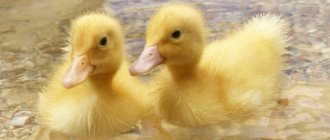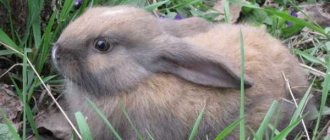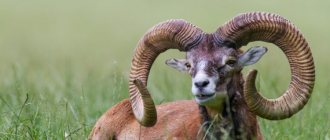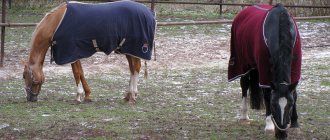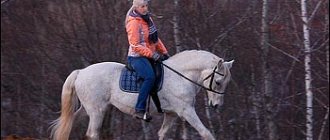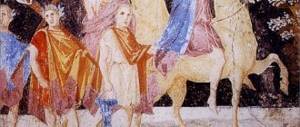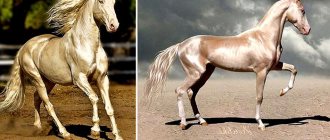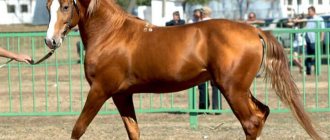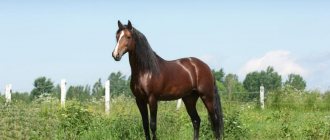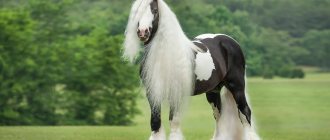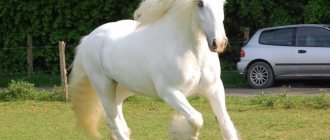Horses have always played a big role in human life and everyday life. In former times, they traveled with their owners and participated in battles. With their help, they covered long distances and moved loads. And of course, peasants could not do without horses. The need for these animals continues to this day, although not so global. The Percheron horse has always stood out among its relatives for its size and endurance. Since the birth of the breed, its strength and power have become in demand in many industries. Now these horses are rightfully considered the decoration of stables, the standard of beauty and greatness.
Percheron horse
Formation of the rock
This breed originated in France. Even its name is consonant with its place of origin in the province of Perche, which occupies four departments south of the Seine. In its very center is the main branch of the breeding control society, on whose initiative the first stud book of this breed was created in 1883.
One of the earliest photographs of Percheron
Experts have mixed opinions regarding the origin of the Percheron. Due to the scarce amount of data, it is not possible to accurately determine the ancestors of the breed. Most French experts are inclined to believe that they were Norman heavy horses crossed with eastern stallions.
Normandy heavy truck
The battle with the Saracens and the birth of the breed
Breeders confidently claim that the breed appeared shortly after the battle with the Saracens in 732 in the Vullier valley. As a result of the battle, a magnificent trophy was captured, consisting of selected Arab and Barbary horses. As a reward, these horses were distributed among the soldiers of the detachment that played a decisive role in the victory and consisted of natives of Persh.
Thus, after the soldiers returned home, the trophy horses were crossed with local draft horses. As a result, a breed appeared that combined the grace and speed of Arabian horses with the strength and endurance of Norman heavy trucks.
Arabian horse
Alternative point of view
There is also a radically opposite opinion expressed by one of the leading experts in France, Eugene Perot. In its version, Percherons are absolutely purebred Arabian horses, which gradually changed their type as a result of the constant influence of an unusual climate and regular crossing of individual representatives of the breed, more suitable for heavy work. This opinion was not approved by other experts due to the lack of any documentary evidence. In addition, the dramatic difference in the exterior of the two breeds did not give Perot's theory a chance to develop.
Points of view on the origin of the breed and the degree of its relationship with Arabian horses diverge
Professor Kuleshov, after studying all the documentary materials, discovered that Percherons at the beginning of the 19th century were significantly different from more modern representatives of the breed. Based on the fact that in earlier periods there is not a single evidence of the presence of these horses at any of the then existing stud farms, he came to the conclusion that the breed was created not so long ago.
According to the professor, the Percheron as a breed was bred to meet the needs of foreign buyers. According to this theory, Norman, Boulogne and, to a lesser extent, Arabian horses participated in the creation of the breed.
It is assumed that genes from several types of horses participated in the creation of the breed.
History of the Percheron horse
The breed originates from the city of Perche, France. It is by the name of the city located south of the mouth of the river. Seine, the horse, got its name. In former times, Percherons were called Arabian horses. But due to climate, farm use and other factors, this horse changed, becoming a massive draft horse. How did this species appear? Local horses (near the city of Perche) were constantly crossed with Barbary or Andalusian horses. The blood of Arabian horses was poured into Percherons twice - in the 8th century and then several centuries later.
The breed originates from the city of Perche, France.
In 1823, the horse Jean le Blanc was born. This is the progenitor of all modern Percherons. The first Percheron studbook was founded in 1923. Thanks to their noble appearance, endurance and other qualities, by that time these horses had gained enormous fame. They began to be imported en masse to North America, distributed throughout Europe, Asia and other parts of the world.
After World War II, a crisis came. In America, this breed survived only thanks to the Amish, who used it as transport and for agricultural work. The most crisis time for Percherons is called 1954 (that year only 85 individuals were recorded). But then, several decades later, the breed again gained popularity not only in America, but also in Europe. Today, Percherons are bred in North America, France, Great Britain and many other countries around the world.
Interesting!
Many draft horse breeds look beautiful, but only the Percheron clearly shows its noble Arabian roots.
Description of the inherent characteristics of the breed
The uniqueness of the Percheron lies in the fact that, under the influence of two different breeds, it combined the power and strength of a heavy draft horse with the grace, dryness and mobility of Arabian horses. These horses are massive and incredibly strong. These are practically the only representatives of their species capable of walking under harness for a long time without stopping. Unlike other heavy trucks, the Percheron is capable of combining fast running and moving large loads.
Percheron size compared to an adult human
The harmonious build of these magnificent animals ensures the ability to maintain a soft ride at any gait. The horse has an impressive chest and powerful physique, while being agile and graceful.
Table 1. Percheron exterior
| Options | Stallion | Mare |
| Height at withers | 1m 62cm | 1m 60 cm |
| Body length | 1m 69 cm | 1m 69 cm |
| Bust | 2m 02 cm | 1m 97 cm |
| Pastern girth | 24.4 cm | 22.7 cm |
General characteristics
Percherons have a head shape characteristic of all heavy trucks. She is not particularly large compared to her large body, but she is quite expressive. The forehead is large, the ears are long, the nose is slightly flattened.
The neck is well set and of medium length. At the withers you can notice the elevation characteristic of strong horses. The croup is straight. A large, muscular back that provides the horse with a smooth ride and maneuverability.
The Percheron inherited its powerful, muscular body from its Norman ancestor.
There are two types of French Percherons:
- small;
- big.
The Small Percheron used to be more popular because it was universal. It was used both as a workhorse and for carriages. It was often called a post horse, since before the advent of the railroad, mail was delivered with the help of a small percheron. This variety has more pronounced features of Arabian horses. The small Percheron, in comparison with the large one, is more graceful and drier-built.
Small Percherons in their features are close to Arabian horses
The large Percheron is closer in size to the Norman draft horses. It was used in agriculture and for moving various heavy objects. If the maximum height at the withers of a small Percheron reaches 160 cm, then for a large one this is only the minimum size. The largest horse of this breed reached a height of 213 cm at the withers. Moreover, the weight of the horse exceeded 1000 kg.
Large Percherons were actively used in agriculture
Suit
Initially, Percherons were of different colors, but as a result of a certain demand, the gray in apples was recognized by the French as the main one. In modern stables, gray and black representatives of this breed predominate. Roans and red ones are found, but much less common.
Despite the presence of other common colors, the gray color of the Percheron is considered the standard
Mane and tail
Percherons have a surprisingly thick, long and airy mane. The tail is long, set low. Previously, tail docking was a mandatory procedure to enhance comfort when riding in harness. Subsequently, representatives of the Humane Society were able to prove that the horse was suffering, unable to ward off insects. Since then they stopped docking the tail.
Percheron with docked tail
Prices for WAHL horse cleaning brushes
Brushes for cleaning horses from dirt WAHL
Legs
The shape of the Percheron's legs differs significantly from other breeds. The limbs are dense and muscular. The forearms are of standard length, with the pasterns being shorter and more muscular. The joints are powerful and large.
History of the breed
There is no exact data on the date and place of appearance of this breed. There are varieties of Belgian, American and English Percheron. It received its main name from the French province of Perche.
Interesting! Many experts agree that it was there that the first Percherons were born.
The local climate favored this: fertile pastures, clean water in streams and cool air. All this extends the period of grazing horses in the open air to 8 months a year.
The time of appearance is considered to be the end of the 18th – beginning of the 19th centuries. It was at this moment that the first records and mentions of this breed appeared.
The Percheron's ancestor is a massive, riding heavyweight, originally from Ancient Rome. There it was actively used for cavalry. During feudalism, the horse found another purpose - transporting a rider in heavy armor. After the era of chivalry ended, the horse began to be used exclusively for harness work: for transporting goods for merchants or weapons and supplies in the army.
Since the mid-19th century, horses of this breed have been used for postal carriages. The breed has become more multifaceted: less heavy, more agile individuals have appeared. This is how the division into large and small Percherons occurred.
The breed flourished at the end of the 19th century. Horses began to be used to operate city omnibuses (the French ancestor of the tram). More than 40 thousand Percherons were purchased annually for these purposes.
In 2021, the popularity of the breed does not fade. She is still bred by the best breeders in France.
Distinctive character traits
Like the vast majority of large, powerful breeds, Percheron horses are a bit slow. At the same time, they are patient, calm and absolutely calm. All these qualities are perfectly combined with the liveliness and mobility of the horse. These horses easily and quickly learn new skills, and the acquired ones are retained for a long time. Percherons do not suffer from the obstinacy and pickiness inherent in thoroughbred horses.
Due to their perseverance and calmness, Percherons are easy to train
Percheron content
Representatives of this unique breed are completely unpretentious. The most important aspects of maintenance are a clean, warm and dry environment.
To properly care for your horse, it is enough to regularly carry out a few simple manipulations:
- preventive veterinary examinations;
- combing the mane with brushes with natural bristles;
- swimming in the heat;
- inspection and removal of dirt from the nose and ears;
- contrast shower after physical activity.
The unpretentiousness of this breed allows you to get by with the simplest hygiene procedures.
Feed
The amount of feed consumed directly depends on the loads the animal receives. The larger they are, the richer and more saturated the diet should be. In the spring and summer, the horse is taken out to pasture, where it can eat fresh grass in sufficient quantities. In winter, grass is replaced with hay.
Prices for “Oatmeal” briquettes for horses and foals
Briquette “Oatmeal” for horses and foals
A horse's diet should include:
- flour;
- oil cake;
- clover (hay).
Combined foods can be included in the Percheron's diet after consultation with a veterinarian
We will talk about the general rules for feeding horses below.
Rules for feeding horses
Prices for felucene mineral lick with magnesium and iron for horses
Felucene mineral lick with magnesium and iron for horses
Content
To maintain cleanliness in the stable, it is necessary to remove excrement and wet bedding every day. Once every seven days, the stables are thoroughly cleaned using disinfectants.
Feeders and drinking bowls will also be disinfected.
The cleanliness of an animal is the key to its health. Horses are brushed every time they are taken out of their stall and after a busy day before entering their stall.
When you tidy up your horse's coat with a brush, you not only remove dust, dirt, and debris, but also massage the skin, improving blood circulation.
During such a procedure, abrasions or other flaws on the skin can be detected, and these should be treated in a timely manner.
The mane and tail require special attention. They need to be combed thoroughly.
Ears and nostrils are examined and cleaned. In hot weather, swimming is a must, and after hard work, a contrast shower.
Feeding
Since Percherons are working horses, the amount of feed they consume should directly depend on their physical activity. The harder they work, the more varied and nutritious the food should be.
Regardless of the load, they need to be fed three to four, or even five times a day. When young greenery appears, the horses are taken out to pasture.
As additives to green feed, they are given compound feed, vitamins and minerals. In winter, grass is replaced with hay and straw.
Such a massive animal should receive at least 20 kg of hay for every 0.5 ton of its weight. Both winter and summer menus need to be diversified with concentrates, root vegetables, and roughage.
Be sure to give meat and bone meal, oil cake, and lick.
Important! Like all heavy draft dogs, Percherons are prone to obesity, so daily exercise is essential for them. In summer this can be regular grazing, in winter it can be 12-kilometer walks or work.
To maintain water balance, a horse needs 4-5 buckets of water per day. In hot weather, its amount doubles. Young animals must be grazed.
They should spend half the day on the pasture, eating fresh grass, the other half in the stall, on dry food. In the summer, their menu should include clover and lungwort.
At the age of 15-19 months, oats are introduced into the diet. They feed 5-6 times a day. In addition to grass, they provide roughage, root vegetables and concentrates.
Any horse should not be given: fresh bread; vegetables (exception: carrots); fruits (except apples, watermelon); dried fruits; sweets; wheat; corn; barley.
Stable care
Percherons are far from small animals, so when building a stable you need to take into account that they require much more free space than other horses.
In cold weather, it is more convenient to keep them in a stall, the dimensions of which should be 370 x430 cm. The ceiling height should be maximum. This will ensure good ventilation.
It is desirable to have a solid wall in the stall, turning into a wooden sheathing. This wall design will protect the animal from possible drafts, will not block the view and create obstacles to communication with its relatives.
Comfortable temperature is 5-15 °C, and humidity is 70%. To maintain the desired microclimate, it is advisable to insulate it when constructing a stable, especially in regions with cold winters.
To prevent the horse from suffering from hoof diseases, the floor in the stall is covered with a layer of sand, peat, straw or sawdust. This bedding will keep you dry.
Sources of daylight in warm weather are windows; in cold weather, lamps come to their aid, creating an illumination of 150-200 lux.
Disease Prevention
The French heavy truck's immunity is quite strong, so it is not often overcome by diseases.
To minimize the likelihood of a particular disease occurring, it is necessary to properly care for the animal.
Regular cleaning of the skin will relieve the horse of skin diseases. Even if a problem has arisen, in this case it will be detected in a timely manner and stopped at an early stage of development.
Hair trimming in winter will also help avoid the manifestation of various infectious diseases. It is equally important to monitor the horse’s equipment.
An incorrectly fitted saddle or harness can easily cause skin diseases.
You should also carefully monitor your diet, then everything will be fine with your digestive system.
Pregnancy and foal development
In the first mentions of the breed, it was indicated that the disadvantage of Percherons is the unstable transmission of breed qualities in comparison with other heavy trucks. This was especially noted when crossing with Russian horses.
This was mainly due to the lack of proper organization of accounting and control of the direction of thoroughbred horses at stud farms of that time. Modern representatives are completely devoid of this drawback and are recognized as a first-class world breed.
Foals of this breed require at least two years to complete physical development.
Pregnancy in such horses is quite easy and without complications. Foals are born quite strong. Like all representatives of heavyweights, Percheron foals are characterized by late maturation. They fully mature at the age of two years.
During the growth period, the foal needs to be provided with long walks and a well-balanced diet.
In summer, they should be in clover pastures most of the day. From the age of 1.5 years, horses begin to be given oats. Feeding young animals should occur strictly at certain times, 5-6 times a day. Regular food is alternated with coarser food (root vegetables).
Daily walks will strengthen the foal's body
Scope of use of Percheron horses
During the formation of the breed, these horses were actively used in almost all areas. The strong and resilient horse was popular with knights, as it easily carried a man-at-arms in bulky armor. This breed was equally effective in the fields, pulling a cart or plow. These horses were in constant demand for use in harness and riding.
Heavy truck harnessed to a team
In the current realities, the demand for heavy trucks has decreased significantly, but they are still used in circus performances or other entertainment programs. Strength combined with grace makes this breed a stunning presence in the arena.
Heavy trucks in agriculture
Percherons and the revolution
During the Great French Revolution of 1789-1799. the Percheron breed was almost lost. Ten years of hostilities and the unstable situation in the country did not have the best impact on the Percheron horse - most of the individuals were destroyed, and breeding new ones was impossible under the conditions of the revolution.
However, Napoleon Bonaparte came to the rescue of the breed. Since his army was in dire need of strong and durable horses, in 1803. Bonaparte signed a decree on the restoration of the breed. Several stud farms were urgently created, where the remaining representatives of the breed were collected.
Around 1820, Arabian and Turkish stallions were brought to Perche. Among them was the famous Gallipoli, whose direct descendant was a stallion named Jean le Blanc, famous in the history of horse breeding in France. It is the active addition of Arab blood that experts explain the gray color and proud posture of modern Percherons.
Breeding in Russia
Percherons were not very common in Russia, as they were imported in small quantities. The first breeder of the breed was the Khrenovsky stud farm. There, by crossing the best representatives of the breed, a Percheron was bred, whose appearance was somewhat different from the standard.
The Russian Percheron differs from the classic one in a number of parameters, but is in no way inferior to it
Later, stud farms in Bryansk, Voronezh and Tambov also began breeding Percherons. Thanks to these stud farms, several new breed lines appeared:
- Iskoda;
- Apra;
- Bardadyma;
- Vuitry.
Unfortunately, due to the lack of new blood flow, the three types disappeared. To date, only the Iscod line exists. The Russian Percheron is distinguished by its large size and incredible endurance.
At the moment, it is possible to purchase a Percheron in Russia only from private breeders
Until 2000, the Ulyanovsk stud farm was closely involved in breeding and improving the breed. Taking into account the experience of its predecessors, the plant regularly purchased breeding stallions for renewal. In 2011, the plant declared itself bankrupt and ceased to exist. Now only private stables pay attention to breeding this breed, which has a strong impact on the cost of horses.
The price of a Percheron horse starts at $10,000. Its formation is influenced by the origin, age and physical characteristics of the horse. Young individuals are usually cheaper, but will require additional training costs.
Breeding
The process of self-breeding Percheron beauties requires certain knowledge about the breeding characteristics of this breed.
- the pregnancy of a Percheron mare , because initially the horse is quite large. Therefore, it is necessary to pay attention to changes in the female’s behavior. The emergence of a desire to defend the territory, as well as aggressiveness towards other horses living with it and increased appetite are the main signs of a horse’s pregnancy. This period lasts from 340 to 350 days, depending on the sex of the foal as well as the season.
- It is important to carefully monitor the pregnant mare's nutrition. Roughage should be minimized, giving preference to the highest quality products. During the third trimester, the horse should receive the maximum amount of nutrients through feed.
- Foals of this breed mature quite late - 2 years after birth. During this time, it is important that their physique becomes correct and their bones become stronger. This is why it is necessary for little Percherons to spend a lot of time outdoors. We should also not forget about a sufficient amount of food to replenish the supply of nutrients and energy for such active animals.
- Even at a young age, horses of this breed show an amazing ability to adapt, so you don’t have to worry about the foals spending a lot of time outdoors.
- If you want to breed a breed for sport riding or hunting , then you need to cross the Percheron with a lighter breed.
- It is also worth remembering that it is officially prohibited to dock the tails of these horses , since this procedure deprives the animals of the opportunity to protect themselves from insects in the summer.
Interesting facts about the breed
- Jean de Birn was recognized as the best manufacturer in the 19th century. He gave birth to a large number of the most valuable representatives of the breed.
Thanks to Jean de Byrne, France today has excellent representatives of the breed
- In 1991, a beer company purchased four stallions of this breed for an advertising campaign. They carried a beer barrel with the inscription “Baltika” in the northern capital. The company subsequently purchased several mares for breeding.
- The famous circus actress Yana Sharikova performed in the arena for a long time with a magnificent specimen of the breed named Pompey. Their joint performance with hoops always delighted the audience.
- In France, horses of this breed are still bred en masse. For the French, the Percheron has not only commercial value, but is also considered a national treasure of the country. The government consistently allocates resources for breeding and improving the breed.
In France, the breeding of Percheron horses is given a particularly important place
- Among other qualities, Percheron horses are valued for their loyalty to their owner. It is difficult to imagine a more devoted creature. Regardless of the breed and color, a horse still remains a faithful friend and reliable assistant for a person. These delightful creatures can dispel sadness in a few moments and give a lot of positive emotions. Percherons are rightfully considered the most colorful and outstanding representatives of their species. It’s not for nothing that interest in the unique breed has not waned for so many years.
Percheron Morocco
The stallion Morocco was a representative of the Percheron breed. His height was recorded as 115 cm, and his weight was 1285 kg, which is also impressive. This breed was used for military purposes.
Interesting facts about this breed are revealed by archaeologists who claim that during the Ice Age there lived large species of horses resembling the modern Percheron breed. It is believed that it was bred in ancient times in the European province of Perche. It was there that large horses lived.
In the 18th century, they began to be crossed with Arabian stallions, as a result of which the modern Percheron breed appeared. These horses are valued for their ability to adapt to different conditions and their ability to maintain the required speed under heavy loads.
